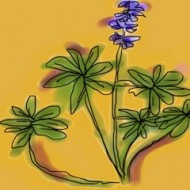The Dry Garden: Coyote mint
Paradise is at once so attainable and so far away.
This column was going to be about how the most immediate and affordable thing that Southern California homeowners could do to reduce our collective dependency on fossil fuel would be to rip out lawn. But events in the Gulf of Mexico are too crazy-making to be sure that it wouldn’t be the garden-writing equivalent of picking a fight at the dinner table. So this column is about coyote mint. Click here to keep reading The Dry Garden in the Los Angeles Times.…
The Dry Garden: Matilija poppies
Two unrelated and equally magical things happen in Southern California in late May and early June. By night, courting mockingbirds sing all night. By day, the Matilija poppies begin their all-too-fleeting bloom. The shame is, while most everyone who sleeps becomes aware of the mockingbird’s song, not everyone with sight will encounter the Matilija, which is, without rival, the biggest, silliest, loveliest and most poignant of California wildflowers.
Click here to keep reading this week’s Dry Garden column in the Los Angeles Times.…
The Dry Garden: Hummers and snapdragons
Channel Islands native Galvezia speciosa amounts to a year-round hummingbird feeder on a negligible water budget. Cal Poly Pomona landscape architect Bob Perry recommends the hybrid 'Firecracker' (above) as being compact and therefore suitable to many gardens. Photo: Bob Perry / Land Design Publishing
If you are considering a hummingbird feeder, try buying a plant instead of a bottle.
For what seems like a year-round fountain of nectar, make that plant a bush snapdragon. Galvezia speciosa, as this Channel Island native is more properly known, flowers four out of four seasons and 365 days a year. Its bright red tubular blossoms clearly evolved with hummingbirds as pollinators, and the birds will stake out your garden the instant the plant goes in the ground.
They are very hard to kill; Galvezia’s only weakness is susceptibility to freezing. Other than that, they can be used throughout most of Southern California. The …
The Dry Garden: Eco-snooping, part three
You might set out on the Theodore Payne Foundation tour this weekend for righteous reasons — to save water, or to help birds and butterflies. But the sheer beauty of Wynne Wilson’s Altadena home will have you wondering, why doesn’t everyone garden with natives? Her partnering of indigenous coral bells and lilac with the Mediterranean staples of citrus and lavender is so stupidly beautiful that you want to cry.
Click here for part three in the Los Angeles Times of The Dry Garden’s preview of this weekend’s Theodore Payne Foundation tour.…
The Dry Garden: Native mallows
Few plants better connote the sheer luxuriance of the California dream as hibiscus. It comes from a clan of plants known as mallows native to the tropics, where, University of Texas botanist Paul A. Fryxell says, this family finds its “greatest richness.”
Fryxell is an authority on mallows, a family that he says has more than 100 genera with cousins around the world, capable of tolerating situations as diverse as the high climes of the Andes, hot and dry Palm Desert and the mediterranean climate of coastal California.
Talk to Fryxell and it soon becomes clear why hibiscuses in Southern California needn’t be a guilty pleasure, even though they’re tropical. Thanks to their robust root systems, many can go with only occasional deep watering during dry season. Once established, they are happiest when treated like trees.
For Californians, he also points to our native mallows. Those who haven’t expanded from …
« go back — keep looking »

